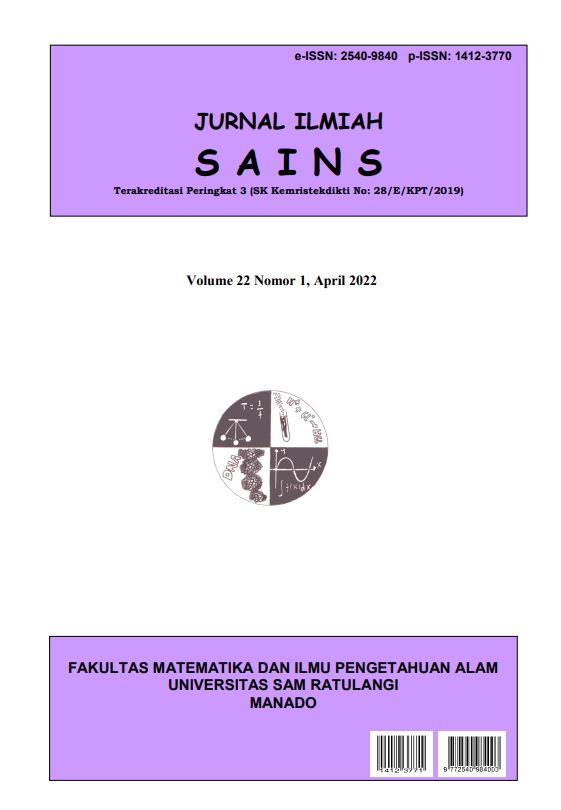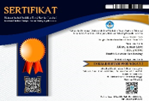Suseptibilitas Magnetik dan Konsentrasi Logam Berat Sedimen Sungai Tallo di Makassar
DOI:
https://doi.org/10.35799/jis.v22i1.38681Abstract
Keberadaan Sungai Tallo sangat penting bagi industri dan masyarakat yang berada di daerah aliran sungai. Namun, aktivitas sosial-ekonomi tidak dibarengi dengan pengelolaan sampah yang bertanggung jawab. Dengan demikian, secara umum sungai tercemar oleh polutan seperti logam berat. Oleh karena itu, perlu dilakukan monitoring sebagai langkah pengendalian kualitas Sungai Tallo untuk menghindari kondisi yang semakin buruk. Tujuan penelitian ini yaitu untuk meningkatkan pemahaman tentang hubungan antara parameter magnetik dan kandungan logam berat pada sedimen Sungai Tallo. Metode yang digunakan adalah metode magnetik lingkungan menggunakan parameter suseptibilitas magnetik. Selanjutnya, dilakukan pengujian X-Ray Fluorescence (XRF) untuk mengetahui konsentrasi unsur logam berat. Hasil menunjukkan Suseptibilitas magnetic sedimen Sungai Tallo berkisar 47,7 sampai 968,7 × 10-8 m3/kg. Suseptibilitas magnetik berhasil mengidentifikasi kelimpahan logam berat pada Sungai Tallo. Fe memiliki konsentrasi yang lebih tinggi dibandingkan Cr, Mn, dan Zn. Korelasi antara unsur logam berat Fe, Mn, dan Zn dengan suseptibilitas magnetik diperoleh korelasi positif kuat dimana unsur logam berat berkontribusi terhadap suseptibilitas magnetik. Studi ini mendukung parameter magnetic seperti suseptibilitas magnetik dapat berpotensial digunakan sebagai indikator polusi logam berat pada Sungai Tallo.
Kata kunci: Logam berat; magnetik lingkungan; suseptibilitas magnetik
Magnetic Susceptibility and Heavy Metal Concentration of Tallo River Sediments in Makassar
ABSTRACT
The existence of the Tallo River is very important for industry and people living in the watershed. However, socio-economic activities are not accompanied by responsible waste management. Thus, rivers are generally polluted by pollutants such as heavy metals. Therefore, monitoring is necessary as a measure to control the quality of the Tallo River to avoid worsening conditions. The purpose of this study was to improve understanding of the relationship between magnetic parameters and heavy metal content in Tallo River sediments. The method used was the environmental magnetic method using magnetic susceptibility parameters. Furthermore, X-Ray Fluorescence (XRF) was tested to determine the concentration of heavy metal elements. The results showed that the magnetic susceptibility of the Tallo River sediments ranged from 47.7 to 968.7 × 10-8 m3/kg. Magnetic susceptibility identified the abundance of heavy metals in the Tallo River. Fe has a higher concentration than Cr, Mn, and Zn. The correlation between heavy metal elements Fe, Mn, and Zn with magnetic susceptibility showed a strong positive correlation where heavy metal elements contribute to magnetic susceptibility. This study supports magnetic parameters such as magnetic susceptibility that can potentially be used as an indicator of heavy metal pollution in the Tallo River.
Keywords: Environmental magnetic; heavy metal; magnetic susceptibilityReferences
Bijaksana, S. & Huliselan, E.K. 2010. Magnetic properties and heavy metal content of sanitary leachate sludge in two landfill sites near Bandung, Indonesia. Environmental Earth Sciences, 60(2): 409–419. https://doi.org/10.1007/ s12665-009-0184-4.
Bijaksana, S., Huliselan, E., Safiuddin, L.O., Fitriani, D., Tamuntuan, G. & Agustine, E. 2013. Rock Magnetic Methods in Soil and Environmental Studies: Fundamentals and Case Studies. Procedia Earth and Planetary Science, 6: 8–13. https://doi.org/10.1016/ j.proeps.2013.01.001.
Dearing, J. 1999. Environmental Magnetic Susceptibility Using the Bartington MS2 System.
Huliselan, E.K. & Bijaksana, S. 2007. Identifikasi Mineral Magnetik pada Lindi (Leachate). Jurnal Geofisika, 2(2004): 8–13.
Hunt, C.P., Moskowitz, B.M. & Banerjee, S.K. 1995. Magnetik Properties of Rocks and Minerals. Rock Physics & Phase Relations: A Handbook of Physical Constants, Vol. 3. American Geophysical Union, Washington DC., pp. 189-204.
Kanu, M.O., Meludu, O.C. & Oniku, S.A. 2014. Comparative study of top soil magnetic susceptibility variation based on some human activities. Geofisica Internacional, 53(4): 411–423. https://doi.org/10.1016/S0016-7169(14) 70075-3.
Mariyanto, M., Amir, M.F., Utama, W., Hamdan, A.M., Bijaksana, S., Pratama, A., Yunginger, R. & Sudarningsih, S. 2019a. Environmental magnetism data of Brantas River bulk surface sediments, Jawa Timur, Indonesia. Data in Brief, 25(2019): 104092. https://doi.org/10. 1016/j.dib.2019.104092.
Mariyanto, M., Amir, M.F., Utama, W., Hamdan, A.M., Bijaksana, S., Pratama, A., Yunginger, R. & Sudarningsih, S. 2019b. Heavy metal contents and magnetic properties of surface sediments in volcanic and tropical environment from Brantas River, Jawa Timur Province, Indonesia. Science of the Total Environment, 675: 632–641. https://doi. org/10.1016/j.scitotenv.2019.04.244.
Mello, D.C., Dematte, J.A.M., Silvero, N. E. Q., Raimo, L.A.D.L., Poppiel, R.R., Mello, F.A.O., Souza, A.B., Safanelli, J.L., Resende, M.E.B. & Rizzo, R. 2020. Soil magnetic susceptibility and its relationship with naturally occurring processes and soil attributes in pedosphere, in a tropical environment. Geoderma, 372: 114364, https://doi.org/ 10.1016/j.geoderma.2020.114364.
Novala, G.C., Fitriani, D., Susanto, K. & Kirana, K.H. 2016. Magnetic Properties of Soils from Sarimukti Landfill as Proxy Indicators of Pollution (Case Study: Desa Sarimukti, Kabupaten Bandung Barat). IOP Conference Series: Earth and Environmental Science, 29(1): 012015. https://doi.org/10.1088/1755-1315/29/1/012015.
Sandi, I.A., Fauzan, M.F.A., Fitriani, Rampe, M.J. & Tiwow, V.A. 2021. A review of the magnetic susceptibility of guano deposits in caves. Journal of Physics: Conference Series, 1899(1). https://doi.org/10.1088/1742-6596/ 1899/1/012125.
Sudarningsih, S., Bijaksana, S., Ramdani, R., Hafidz, A., Pratama, A., Widodo, W., Iskandar, I., Dahrin, D., Fajar, S.J. & Santoso, N.A. 2017. Variations in the concentration of magnetic minerals and heavy metals in suspended sediments from citarum river and its tributaries, West Java, Indonesia. Geosciences (Switzerland), 7(3). https://doi.org/10. 3390/geosciences7030066.
Tamuntuan, G., Bijaksana, S., Gaffar, E., Russell, J., Safiuddin, L.O. & Huliselan, E. 2010. The magnetic properties of Indonesian Lake Sediment: A case study of a tectonic lake in South Sulawesi and maar lakes in East Java. ITB Journal of Science, 42A(1): 31–48. https://doi.org/ 10.5614/itbj.sci.2010.42.1.4.
Tiwow, V.A., Subaer, Sulistiawaty, Malago, J.D., Rampe, M.J. & Lapa, M. 2021. Magnetic susceptibility of surface sediment in the Tallo tributary of Makassar city. Journal of Physics: Conference Series, 1899(1). https://doi.org/10.1088/1742-6596/1899 /1/012124.
Tiwow, V.T., Arsyad, M., Sulistiawaty, Rampe, M.J. & Tiro, W.I.B. 2019. Analysis of magnetic mineral types of iron sand at sampulungan beach, takalar regency based on magnetic susceptibility values. In Materials Science Forum: (967) MSF. https://doi.org/10.4028/ www.scientific.net/MSF.967.292.
Tiwow, V.A., Rampe, M.J. & Arsyad, M. 2018. Kajian suseptibilitas magnetik bergantung frekuensi terhadap pasir besi Kabupaten Takalar. Sainsmat : Jurnal Ilmiah Ilmu Pengetahuan Alam, 7(2): 136-146. https://doi.org/10.35580/ sainsmat7273662018.
Togibasa, O., Bijaksana, S. & Novala, G.C. 2018. Magnetic properties of iron sand from the tor river estuary, sarmi, papua. Geosciences (Switzerland), 8(4): 1–7. https://doi.org/10.3390/geosciences8040113
Ulfa, Y.S. & Budiman, A. 2019. Analisis Suseptibilitas Magnetik Tanah Pada Lahan Perkebunan Kopi di Kabupaten Solok. Jurnal Fisika Unand, 8(3): 219–226. https://doi.org/10.25077/jfu.8.3. 219-226.2019.
Wahyuni, E.S. & Afdal, A. 2018. Identifikasi hubungan kandungan logam berat dengan nilai suseptibilitas magnetik pada tanah lapisan atas di Kota Sawahlunto. Jurnal Fisika Unand, 7(1): 1–7. https://doi.org/10.25077/jfu.7.1.1-7.2018.
Wang, J., Liu, R., Zhang, P., Yu, W., Shen, Z. & Feng, C. 2014. Spatial variation, environmental assessment and source identification of heavy metals in sediments of the Yangtze river estuary. Marine Pollution Bulletin, 87(1): 364–373. https://doi.org/10.1016/j. marpolbul.2014.07.048 .
Xu, Y., Sun, Q., Yi, L., Yin, X., Wang, A., Li, Y. & Chen, J. 2014. The source of natural and anthropogenic heavy metals in the sediments of the Minjiang river estuary (SE China): Implications for historical pollution. Science of the Total Environment, 493: 729–736. https://doi. org/10.1016/j.scitotenv.2014.06.046.







